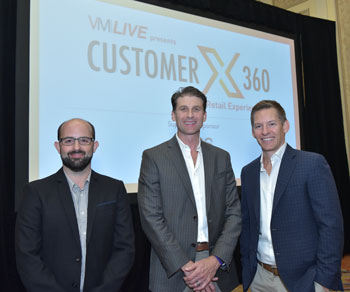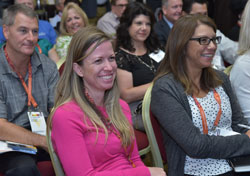 (L to R) VM LIVE speakers Stephen Crossland, Fuel3D; Michael Kling,
(L to R) VM LIVE speakers Stephen Crossland, Fuel3D; Michael Kling,
OD, of San Diego-based Invision Optometry; and Peter Bridgman,
LensCrafters, NA.LAS VEGAS—Rapid changes in technology and shifting consumer expectations are two key elements driving a reassessment of the retail customer experience, a group of speakers at VM LIVE’s “Customer X 360” session explained. The program, presented by Vision Monday and held here at the start of Vision Expo West, offered a standing-room only crowd of optical retailers and suppliers the perspectives of Michael Kling, OD, of San Diego-based Invision Optometry, Peter Bridgman of LensCrafters NA, and Stephen Crossland of the 3D capture and imaging innovation company Fuel3D.
The session was designed to demonstrate “how technology intersects with the practice of optometry and how technology is changing this dynamic today,” Marc Ferrara of Jobson Medical Information said in his welcoming remarks. The Supporting Sponsor for Wednesday’s VM LIVE event was ACEP/ABS Smart Mirror.
There is no doubt that technology plays a much larger role in all aspects of retail today, and it is beginning to make more of an impact on the vision care customer experience, noted Jobson group editor Andrew Karp in his introduction of the speakers. The mix of advanced technologies, data management and new presentation elements are combining to raise customer experience in vision care to new levels.
“The interesting thing about CX is that it’s so varied,” Karp said. “There is a lot of science involved, and there’s a lot of art involved, also.”
Crossland set the stage for the discussion with his comments about where Fuel3D sees the “next industrial revolution” playing out in product design. The next revolution will center upon the combination of custom manufacturing and scalability. Crossland noted that before the first industrial revolution all products were custom-made and tailored to the individual, whether it was shoes, suits or eyewear.
“What we’re really talking about today when we say the ‘next industrial revolution’ is a combination of [mass production and customization],” he said. “It’s customization that retains the scalability of manufacturing and retains the low cost of goods.”
 Customer X 360 attracted nearly 200 optical
Customer X 360 attracted nearly 200 optical
retailers and suppliers. He said the impetus for the redesign came from the realization that the practice was not branded very well. “Our brand was very undefined, and we had inconsistencies in the brand that needed to be addressed,” he said.
Among the major changes in design was the elimination of the front desk area, which, he joked, “is where everything bad that ever happened has happened.” To replace the front desk, the practice now has a coffee bar with a greeter.
Other changes include the addition of new wood and glass shelves for displaying frames, creation of a more open environment that provides patients the space they need to shop, and moving the “operations” part of the business to the back of the practice in a section of private rooms.
By moving the operations element, it “created a calmness in the front,” he explained. He also added a new conference room area for “collaboration” meetings, he said, which turned out to be a fantastic investment.
To view a slideshow of attendees and speakers at VM LIVE: Customer X 360, click here.
LensCrafters’Bridgman, a Luxottica executive who moved into the general manager role at LensCrafters at the beginning of the year, is working on a redesign to make the stores more modern and “open” looking, and a shift away from the clinical look. He said today’s patients want convenience, but they also want a unique experience. One way LensCrafters is addressing this is by making improvements to its customer relationship management programs, he said.
Bridgman, who has a background in health care, also said changes in health care, driven by the Affordable Care Act (ACA) and other factors, will play a bigger role in the eyecare experience for patients going forward. Preparing for these changes will be critical.
“We’re in an evolution, and changes in health care is demanding that we evolve,” he said. “As we think about the evolution of LensCrafters, we want to be a health care company and prioritize vision care for a more discernible shopping American. We’re looking at the left and the right, and surrounding the patient with care and product experience.”
This has resulted in a greater focus on doctor quality perception, the wider use of technology, and a reduction in the number of frames that are displayed, he said.